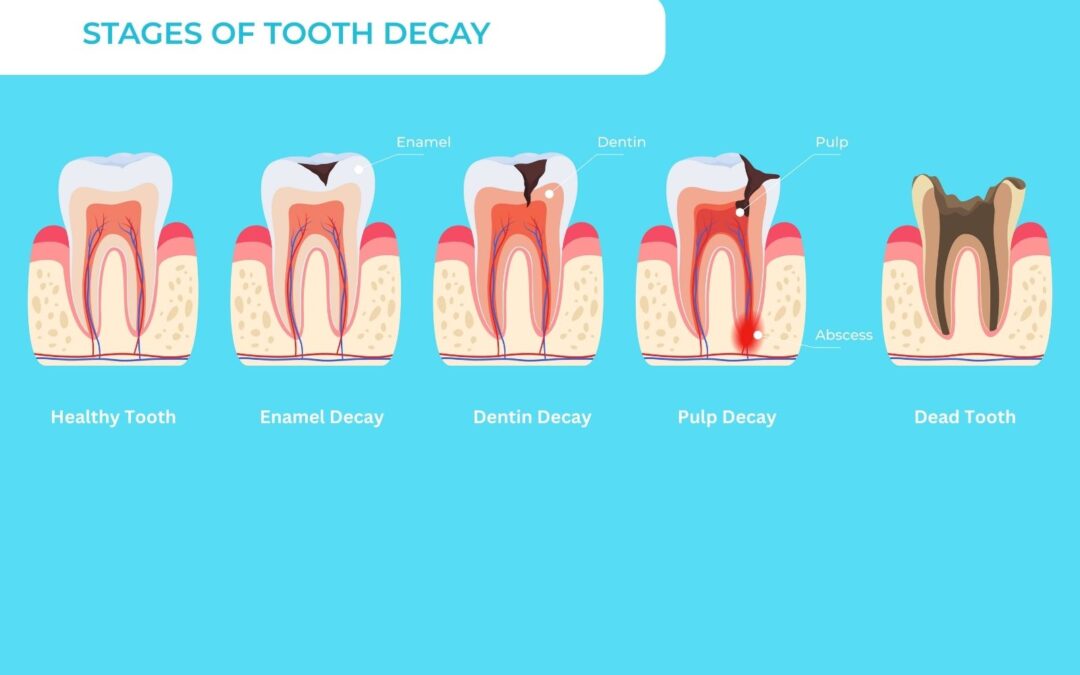What are the stages of tooth decay?
Tooth decay has several stages. Knowing and understanding them is essential because if good dental hygiene has not kept the cavities away, good awareness can help you get early treatment and preserve your natural teeth.

Before we explore tooth decay, we’ll give you an overview of your teeth anatomy.
Teeth are fascinating structures, and they’re made up of several different layers, each with its unique composition:
- Enamel: The enamel is the outer layer of your teeth that serves as a protective shell. Enamel, the hardest substance in the body, is primarily composed of minerals, with hydroxyapatite crystals being the main component. These crystals made up of calcium and phosphate ions, giving enamel strength and durability.
- Dentin: Beneath the enamel is a hard tissue called dentin, which forms most of the tooth structure. Although not as hard as enamel, dentin is still quite durable. It is comprised of mineralized tissue, primarily hydroxyapatite crystals, organic material, and water.
- Pulp: The tooth’s pulp is soft tissue containing nerves, blood vessels, and connective tissue. It is essential for nourishing the tooth and providing sensation. The dentin encases the pulp, protecting it along with the outer enamel.
- Cementum: In the teeth’ roots, a cementum layer covers the dentin. Cementum, similar to bone, anchors teeth securely via the periodontal ligament.
- Periodontal Ligament: The periodontal ligament, which attaches the tooth to the bone and cushions it during chewing, surrounds each tooth.
These components work together to form a strong and functional tooth that allows us to bite, chew, and speak properly. Proper oral hygiene practices are the foundation to ensuring the health and functioning of your teeth throughout your life.
Now let’s talk tooth decay.
Tooth decay happens in stages, just like a story with different chapters. Let’s break it down:
- Initial Stage (Enamel Decay): This is where the story begins! The acid-producing bacteria in your mouth weaken the tooth’s enamel layer. You might not notice anything happening, but it’s the beginning of trouble.
- Early Stage (Dentin Decay): As the bacteria continue to grow on your tooth, they dig deeper, reaching the dentin—the layer beneath the enamel. Dentin is softer than enamel, so that that decay can spread faster here. You might feel a slight sensitivity or pain at this point, especially when eating sweets or drinking cold or hot stuff.
- Moderate Stage (Pulp Decay): Things are getting serious now! If the decay isn’t stopped, it can reach the pulp—the innermost part of your tooth that contains nerves and blood vessels. This can cause some severe pain and discomfort, like a toothache.
- Advanced Stage (Abscess Formation): This is the climax of our story, and it’s not a happy one. If the decay keeps spreading, it can lead to the formation of an abscess—a pus-filled pocket at the root of your tooth. An abscess can cause intense pain, swelling, and infections that may spread.
- Final Stage (Tooth Loss): Sadly, if the decay isn’t treated in time, it can destroy your tooth beyond repair. Ultimately, you might have to say goodbye to your tooth as it’s extracted or falls out on its own. But don’t worry; there are ways to replace lost teeth and keep your smile shining bright!
To prevent tooth decay from advancing through different stages, it’s important to maintain good daily oral hygiene practices such as regular brushing and flossing, visiting your dentist for check-ups, and consuming a healthy diet with minimal sugary snacks and drinks. By following these guidelines, we can ensure that our teeth remain healthy and strong.
As always, we at ABC Dental are here to answer all of your questions and help you keep your smile beaming.
Our team is here to answer any questions you have. You can also schedule an APPOINTMENT with one of our top Chicago dentists: Schedule online or Call us at 773-481-2200

